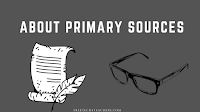07 Jan About Primary Sources
As a U.S. History teacher one my primary goals was to help students understand the past to understand where we (Americans) came from to understand how we got here and to, hopefully, avoid mistakes of the past. To that end, I frequently had students read excerpts from primary source documents. Sometimes that meant confronting language and sentiments while common at the time of writing would be completely unacceptable if they were written today.
Confronting primary source documents whose content if written today would be completely unacceptable becomes a very teachable moment in terms of helping students understand the context (physical as well as political and cultural) in which the documents were written. It’s also an opportunity to teach how and why change happened.
It is difficult to teach with primary sources if students don’t first fully understand the differences between primary and secondary sources. That’s every year that I taught U.S. History began with lessons on identifying primary and locating primary source documents. To that end, I have a few resources that helped me help my students and I hope will help you as well.
Compare textbooks, primary sources, and Wikipedia.
One of my favorite ways to use the commenting feature in Google Documents is to host online discussions around a shared article. Through the use of comments connected to highlighted sections of an article I can guide students to important points, ask them questions, and allow them to ask clarifying questions about the article. All the steps for this process are outlined in Using Google Documents to Host Online Discussions of Primary Sources. A variation on this activity can be completed with Formative. I outlined that process here.
The Gale Family Library at the Minnesota History Center offers this good and concise video explanation for students. My friends Lee and Sachi at Common Craft also offer an excellent video explanation of the differences between primary and secondary sources.
As a U.S. History teacher one my primary goals was to help students understand the past to understand where we (Americans) came from to understand how we got here and to, hopefully, avoid mistakes of the past. To that end, I frequently had students read excerpts from primary source documents. Sometimes that meant confronting language and sentiments while common at the time of writing would be completely unacceptable if they were written today. Confronting primary source documents whose content if written today would be completely unacceptable becomes a very teachable moment in terms of helping students understand the context (physical as well as political and cultural) in which the documents were written. It’s also an opportunity to teach how and why change happened. It is difficult to teach with primary sources if students don’t first fully understand the differences between primary and secondary sources. That’s every year that I taught U.S. History began with lessons on identifying primary and locating primary source documents. To that end, I have a few resources that helped me help my students and I hope will help you as well. Compare textbooks, primary sources, and Wikipedia.This is a rather simple activity that I’ve done over the years as an introduction to the value of primary sources. In the activity I provide students with a textbook entry, a Wikipedia entry, and a primary source document about the same event or topic. I then have them read all three and compare the information about the event. The outline of questions for students is available in this Google Document that I created.Guided reading of primary sources through Google Documents.One of my favorite ways to use the commenting feature in Google Documents is to host online discussions around a shared article. Through the use of comments connected to highlighted sections of an article I can guide students to important points, ask them questions, and allow them to ask clarifying questions about the article. All the steps for this process are outlined in Using Google Documents to Host Online Discussions of Primary Sources. A variation on this activity can be completed with Formative. I outlined that process here. What’s the Difference Between a Primary and a Secondary Source?The Gale Family Library at the Minnesota History Center offers this good and concise video explanation for students. My friends Lee and Sachi at Common Craft also offer an excellent video explanation of the differences between primary and secondary sources. Disclosure: I have a long-standing in-kind relationship with Common Craft. 


Sorry, the comment form is closed at this time.